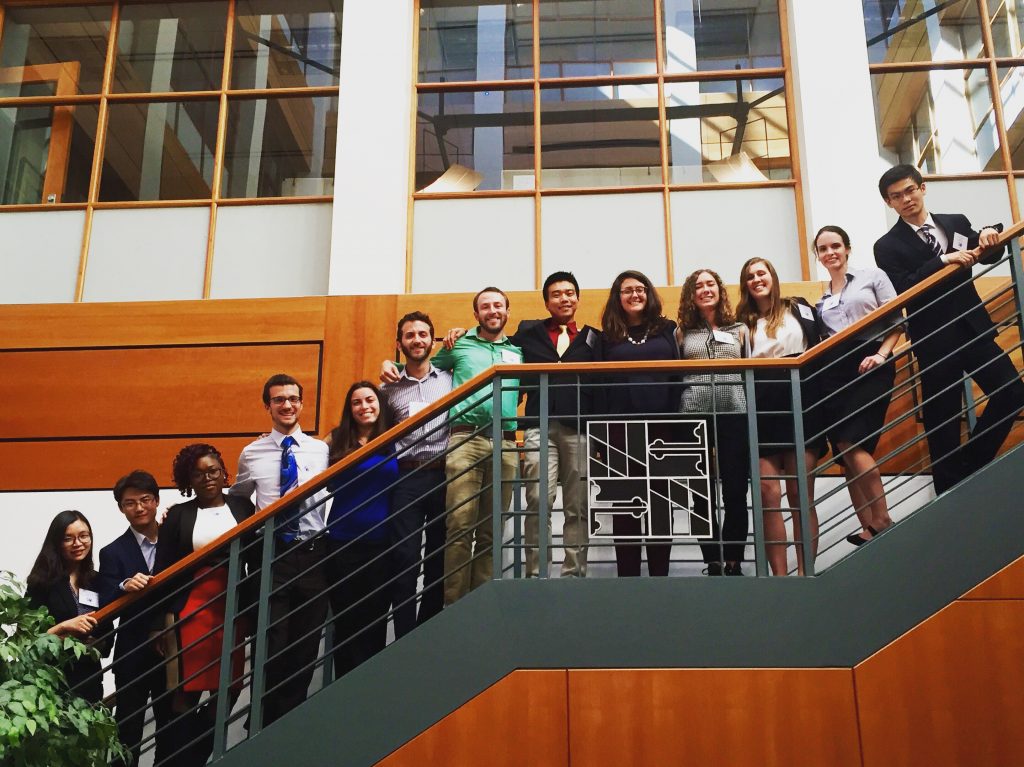It was the kind of Saturday that makes you want to drop everything and run outside. The sun was shining, the leaves were beginning to show their fall colors, and homework wouldn’t be due for at least two more days.
But that glorious Saturday found me hunkered down in a small, windowless room alongside 15 of my Nicholas School classmates, sipping weak coffee and arguing over words, lit up on a projector, that none of us had read until the night before.
Welcome to the 2016 Inter-University Climate Change Negotiation!
Hosted by the University of Maryland, the Inter-University Climate Change Negotiation (ICCN) gave us a chance to simulate the climate negotiations that will happen for real next month in Morocco, when delegates to the UN Framework Convention on Climate Change (UNFCCC) attend the 22nd annual Conference of the Parties (COP). It’s the first COP since the landmark Paris Agreement was signed last year, and now the work begins on turning that document into real policy. As one official from the Moroccan delegation put it, 2016 will be the “COP of action.”
The ICCN was the perfect opportunity for those of us at the Nic School who are fascinated by international climate policy to get our feet wet in the field – and there are a lot of us. Our delegation accounted for at least a third of the student negotiators in attendance.

We were assigned countries to represent ahead of time, and researched their climate viewpoints in the days leading up to the negotiations (or, for some of us, in the passenger seat on the drive to Maryland). I was selected to represent Madagascar – a country that will be among the most vulnerable to climate change, given its susceptibility to drought and cyclones.
The ICCN weekend began with a bang, as UN Secretary General Ban Ki-Moon addressed students and faculty at the University of Maryland. Ban stressed the importance of leading by example on climate change. He was confident, he said, that the progress he’s made on bringing together nations to reduce greenhouse gas emissions will continue after his term expires in December.
The day-long ICCN negotiating session that followed Ban’s speech impressed upon me just how remarkable it was that Ban – or anyone else for that matter – was ever able to broker an international agreement on climate change.
The task before us seemed simple enough: we had a 3-page agreement governing countries’ pledges on climate action to negotiate, and eight hours to do it. But the reality of how hard that task would be set in quickly.
We spent at least half the time debating prepositions: was it appropriate to say that all countries “shall” update their pledges in 2020? Or “should” they? Then there were more fundamental, thorny questions: should we require that countries review and comment on each others’ pledges? Or should that review be optional?
Pretty soon, my head began to swim. Maybe it was all the talk of rising sea levels?

As it turns out, those of us debating “shoulds” and “shalls” in the basement of the University of Maryland weren’t the only ones wrestling with policies to fight climate change. In the world of real-life negotiations on climate change, October has been a pretty astounding month.
On October 2, India ratified the Paris Agreement. This was a huge victory for the UN process. By securing the official support of the third-largest carbon emitter in the world, not to mention one of its fastest-growing economies, India paved the way for the first truly global plan to reduce carbon emissions to take effect.
Now, it’s clear that climate change is not just a problem for the rich countries that have historically polluted the most, or for the small island states that may soon be underwater. As of November 4, when the Paris Agreement officially comes into force, over 190 countries will be tackling that challenge together.
October has also seen airlines get in on the act to fight climate change. The amount of planet-warming gases produced by air travel is growing quickly, and an international agreement in Montreal this month introduced the first ever plan to reduce carbon emissions from flying.
Finally, on the very day my classmates and I were simulating climate negotiations in the Washington D.C. area, Secretary of State John Kerry and his real team of negotiators were half a world away in the East African nation of Rwanda. There, they announced a breakthrough international deal to phase out hydrofluorocarbons, better known as HFCs, across the world in the next decade and a half.
HFCs, commonly used in refrigeration and air conditioning, are a greenhouse gas 1,000 times stronger than CO2. Secretary Kerry told negotiators in Rwanda that their deal to discontinue HFCs was “the single most important step we could take at this moment to limit the warming of our planet,” according to the New York Times.
Our inter-university negotiation may not have had the real impact of India, Montreal, or Rwanda this month. But it did infect me with the diplomacy bug. This is silver buckshot on a global scale.
Plus, in an age where every news cycle brings fresh stories of war, mistrust and conflict, what could be more welcome than people of all nations working together for a healthier planet?
